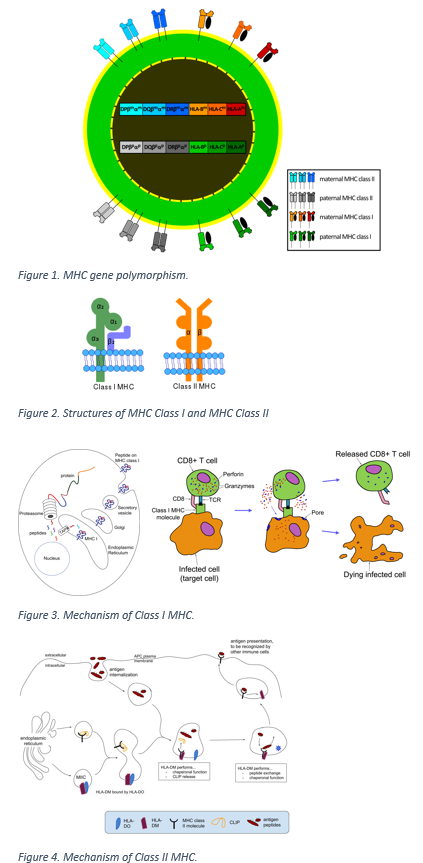[1]
Kelly A, Trowsdale J. Introduction: MHC/KIR and governance of specificity. Immunogenetics. 2017 Aug:69(8-9):481-488. doi: 10.1007/s00251-017-0986-6. Epub 2017 Jul 10
[PubMed PMID: 28695288]
[2]
Alvaro-Benito M, Morrison E, Wieczorek M, Sticht J, Freund C. Human leukocyte Antigen-DM polymorphisms in autoimmune diseases. Open biology. 2016 Aug:6(8):. doi: 10.1098/rsob.160165. Epub
[PubMed PMID: 27534821]
[3]
Meyer D, C Aguiar VR, Bitarello BD, C Brandt DY, Nunes K. A genomic perspective on HLA evolution. Immunogenetics. 2018 Jan:70(1):5-27. doi: 10.1007/s00251-017-1017-3. Epub 2017 Jul 7
[PubMed PMID: 28687858]
Level 3 (low-level) evidence
[4]
Meissner TB, Liu YJ, Lee KH, Li A, Biswas A, van Eggermond MC, van den Elsen PJ, Kobayashi KS. NLRC5 cooperates with the RFX transcription factor complex to induce MHC class I gene expression. Journal of immunology (Baltimore, Md. : 1950). 2012 May 15:188(10):4951-8. doi: 10.4049/jimmunol.1103160. Epub 2012 Apr 6
[PubMed PMID: 22490869]
[5]
Roche PA, Furuta K. The ins and outs of MHC class II-mediated antigen processing and presentation. Nature reviews. Immunology. 2015 Apr:15(4):203-16. doi: 10.1038/nri3818. Epub 2015 Feb 27
[PubMed PMID: 25720354]
[6]
Bailey A, Dalchau N, Carter R, Emmott S, Phillips A, Werner JM, Elliott T. Selector function of MHC I molecules is determined by protein plasticity. Scientific reports. 2015 Oct 20:5():14928. doi: 10.1038/srep14928. Epub 2015 Oct 20
[PubMed PMID: 26482009]
[7]
Molnarfi N, Schulze-Topphoff U, Weber MS, Patarroyo JC, Prod'homme T, Varrin-Doyer M, Shetty A, Linington C, Slavin AJ, Hidalgo J, Jenne DE, Wekerle H, Sobel RA, Bernard CC, Shlomchik MJ, Zamvil SS. MHC class II-dependent B cell APC function is required for induction of CNS autoimmunity independent of myelin-specific antibodies. The Journal of experimental medicine. 2013 Dec 16:210(13):2921-37. doi: 10.1084/jem.20130699. Epub 2013 Dec 9
[PubMed PMID: 24323356]
[8]
Alelign T, Ahmed MM, Bobosha K, Tadesse Y, Howe R, Petros B. Kidney Transplantation: The Challenge of Human Leukocyte Antigen and Its Therapeutic Strategies. Journal of immunology research. 2018:2018():5986740. doi: 10.1155/2018/5986740. Epub 2018 Mar 5
[PubMed PMID: 29693023]
[9]
Aljabri A, Vijayan V, Stankov M, Nikolin C, Figueiredo C, Blasczyk R, Becker JU, Linkermann A, Immenschuh S. HLA class II antibodies induce necrotic cell death in human endothelial cells via a lysosomal membrane permeabilization-mediated pathway. Cell death & disease. 2019 Mar 8:10(3):235. doi: 10.1038/s41419-019-1319-5. Epub 2019 Mar 8
[PubMed PMID: 30850581]
[10]
Peng B, Zhuang Q, Yu M, Li J, Liu Y, Zhu L, Ming Y. Comparison of Physical Crossmatch and Virtual Crossmatch to Identify Preexisting Donor-Specific Human Leukocyte Antigen (HLA) Antibodies and Outcome Following Kidney Transplantation. Medical science monitor : international medical journal of experimental and clinical research. 2019 Feb 3:25():952-961. doi: 10.12659/MSM.914902. Epub 2019 Feb 3
[PubMed PMID: 30712055]

